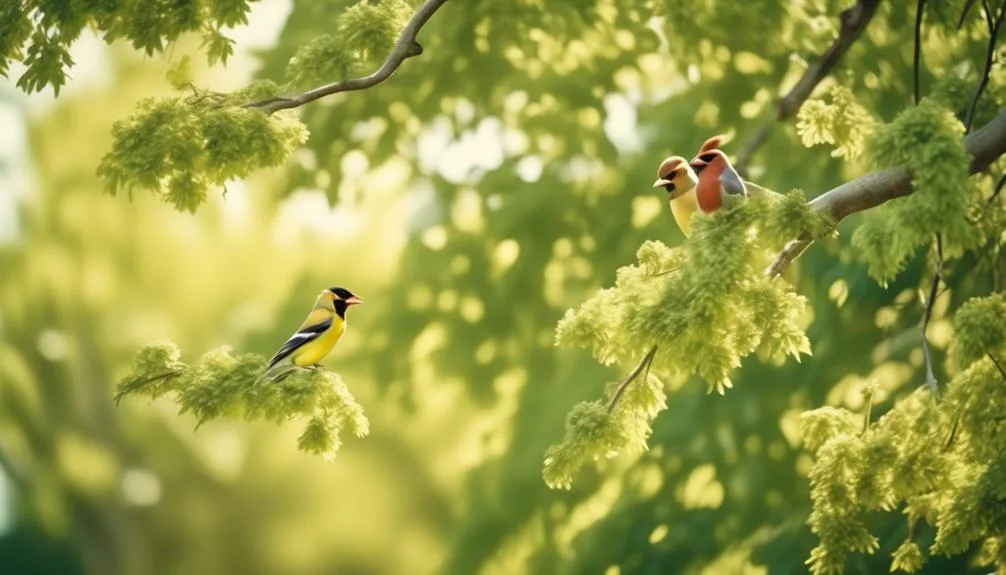Ever wondered why certain birds are drawn to elm trees?
There's a fascinating relationship between these majestic trees and specific bird species. Understanding this connection offers insight into nature's intricate web and the significance of elm trees in the avian world.
These trees play a crucial role in attracting and supporting particular bird populations. Learning about this relationship may challenge your perspective on the natural world.
Elm Trees and Bird Species
If you want to attract a variety of bird species to your yard, planting elm trees is an excellent choice. Elm trees are known for their ability to attract a diverse range of bird species due to their favorable characteristics.
During bird migration seasons, elm trees serve as crucial resting and foraging spots for birds. Their dense foliage provides ample shelter, while the seeds and insects found in and around elm trees offer a readily available food source. This combination makes elm trees highly attractive to a wide variety of bird species, contributing to increased bird species diversity in your yard.
Elm Trees: A Bird-Friendly Habitat
Elm trees' remarkable ability to attract a diverse range of bird species makes them a truly bird-friendly habitat, enriching your outdoor space with increased biodiversity and natural beauty. These majestic trees provide an ideal environment for birds, making your surroundings come alive with the soothing sounds of nature.
Here's why elm trees are an excellent habitat for birds:
- Their dense foliage offers ample protection and nesting sites.
- Elm tree seeds and insects attract a variety of bird species.
- The tree's height provides an excellent vantage point for birds to scout for food and predators.
- Proper tree maintenance ensures a healthy ecosystem for birds to thrive.
- Bird diversity flourishes in the presence of these magnificent trees.
Elm Trees and Bird Feeding Habits
When considering the bird feeding habits associated with elm trees, it becomes evident that these majestic trees play a crucial role in sustaining and nurturing diverse avian species in their natural habitat.
Elm trees provide an abundant source of food for birds, including insects, seeds, and sap. Their dense foliage offers shelter and nesting sites, which attract a variety of bird species. The unique architecture of elm branches also provides an ideal platform for birds to perch and forage for food.
Additionally, the tree's intricate bark crevices harbor insects, catering to the foraging behaviors of insect-eating birds. Understanding bird behavior and tree ecology is essential in comprehending the intricate relationship between elm trees and the feeding habits of avian species.
Elm trees not only provide sustenance but also contribute significantly to the overall biodiversity of bird populations in their ecosystem.
Elm Trees and Nesting Preferences
To attract a variety of bird species to your outdoor space, consider the nesting preferences of elm trees and how they provide ideal shelter and breeding sites. Elm tree nesting offers a diverse and dynamic habitat for birds, influencing population dynamics and fostering a thriving avian community.
Here's why elm trees are a preferred nesting site for birds:
- Tree Canopy Nesting: Elm trees provide a dense canopy that offers protection from predators and the elements, creating a secure environment for nesting.
- Abundant Nesting Sites: The sturdy branches and ample foliage of elm trees offer numerous options for birds to build their nests, supporting a higher bird population.
- Ideal Breeding Ground: Elm trees provide a stable and supportive environment for birds to lay eggs and raise their young, contributing to successful breeding.
- Natural Camouflage: The foliage of elm trees provides natural camouflage for bird nests, helping to safeguard eggs and nestlings from predators.
- Seasonal Shelter: Elm trees offer year-round nesting opportunities, accommodating birds with varying nesting preferences throughout the seasons.
Elm Trees and Bird-Friendly Environment
Creating a bird-friendly environment around your elm trees can significantly enhance the overall habitat and attract a diverse array of avian species to your outdoor space. Birds are attracted to elm trees not only for their sturdy branches but also for the supportive ecosystem that surrounds them. By understanding bird behavior and the importance of the tree canopy, you can create an environment that is conducive to attracting and supporting various bird species. Consider incorporating the following elements into your outdoor space:
| Bird-Friendly Environment Components | Description |
|---|---|
| Native Plants | Plant native flowers and shrubs to provide food and shelter for birds. |
| Water Source | Install a birdbath or small pond to offer birds a place to drink and bathe. |
| Nesting Boxes | Provide nesting boxes to encourage birds to make homes near your elm trees. |
| Bird Feeders | Offer a variety of bird feeders to attract different bird species with various dietary preferences. |
Conclusion
In observing the diverse bird species that find sanctuary in elm trees, we witness the harmonious coexistence between nature and its inhabitants.
Let's cherish the invaluable role these trees play in providing a home for our feathered companions and the beauty of their interconnected ecosystem.

My interest in trees started when I first saw the giant sequoias in Yosemite.
I was a teenager then, and I remember thinking, “I need to learn more about this.”
That moment stuck with me.
A few years later, I went on to study forestry at Michigan Tech.
Since graduating, I’ve worked in a mix of hands-on tree care and community education.
I’ve spent over ten years helping people understand how to plant, maintain, and protect the trees in their neighborhoods.
I don’t see trees as just part of the landscape.
They are living things that make a real difference in our daily lives.
